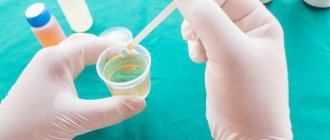Why so much?
Among the whole series of “pregnant” tests, urine testing is the most common. He checks in at the antenatal clinic almost every week. This is because urine tells doctors about the condition of a pregnant woman even more than she herself can tell at the appointment.
First of all, using urine, specialists determine whether pathological processes such as a urinary tract infection have begun in the body of a pregnant woman, which can affect the development of the fetus. The discharge can also be used to judge gestosis, a process that can be extremely dangerous for the expectant mother. It is necessary to recognize it as early as possible in order to avoid sad consequences.
Along with urine, many other substances are excreted from the body, in particular vitamins, salts and hormones. Therefore, from these secretions it is possible to track how other organs work, and not just the kidneys that produce this fluid.
In addition, urine very quickly begins to reflect changes occurring in the body of any person. That is why doctors require this test for colds, rotavirus, and pregnancy. Changes in a number of indicators indicate certain processes occurring with the expectant mother. Only a specialist doctor can decipher them.
Photo source: freepik
Here are the parameters that experts evaluate when studying a urine sample from a pregnant woman:
- Color. It is known that urine is yellow, but only a specialist can distinguish all its 50 shades. The color of this liquid depends on the concentration of the urochrome pigment. It can change if a person takes medications (aspirin, for example, turns urine pink) or if pathological processes occur in the patient's body. Thus, the presence of blood in the analysis indicates problems with the kidneys and bladder, red discharge indicates cystitis or acute inflammation. And if the liquid looks like beer, its owner probably has liver disease.
- Transparency. During pregnancy, it is especially important that it be full - then experts draw a conclusion about the normal state of the woman’s body. But cloudy liquid in the container may indicate pathology.
- Specific gravity is the level of content of microelements, salts and various chemical compounds in the analysis. Normally, this figure is 1003-1035 g/l. With toxicosis it may be less, and with chronic renal failure or diabetes insipidus it may be more.
- Protein. Another very important indicator for pregnant women. In normal analysis it is completely absent. The presence of protein in the liquid reflects inflammatory processes in the organs of the excretory system. He can also talk about late gestosis, which is vitally important to prevent before it begins to seriously affect the condition of the expectant mother.
- The presence of glucose is a sign of diabetes.
- The presence of bilirubin, a special blood pigment that can be found in urine, signals liver disease or problems with the outflow of bile.
- Urobilinogen - its appearance may indicate poisoning or liver disease.
- Ketone bodies, the presence of which in urine can also indicate diabetes.
This is just some of what can be detected in a urine sample from a pregnant woman. Also, the mandatory points of the analysis include checking for nitrites, leukocytes, red blood cells, salts, amorphous phosphates and bacteria. All together, this will allow us to create a complete picture, if not about the entire body, then at least about its excretory system and hormones.
Research during pregnancy
One of the materials required to conduct a study of the changes occurring in the body of a pregnant woman is urine. Based on the results of such an analysis, it is possible to monitor the functioning of the kidneys, which experience additional stress during pregnancy. The presence of various types of disorders in the body of a pregnant woman is an indication for hospitalization. That is why it is necessary to conduct appropriate research as often as possible, which will help identify the problem at the initial stages.
On the eve of the test, you should never eat certain foods or take medications, especially diuretics. In addition, before taking a urine test, you should never overexert yourself, because this can significantly affect the final result and it will be somewhat distorted.
The collected samples must be delivered for testing as quickly as possible, because over time they may contain pathogenic organisms and various types of infections.
General urine analysis
If the gynecologist or therapist wrote in the direction of “General analysis”, you must take the morning urine that collected in the bladder overnight. The first urination of the day does not reflect the fluctuations that can occur with the liquid during the day, so this urine is the most objective. You need to deliver at least 70 milliliters to the clinic.
Before defecating in a jar, you should go to the shower and wash yourself, otherwise excess red and white blood cells may get into the container, which will only cause questions from specialists. You can wash with a soapy solution (but after that, be sure to rinse the external genitalia with boiled water!) or a 0.1% solution of potassium permanganate.
The very first drops of morning urine can be flushed down the toilet, and after a few seconds of the process, you can aim at the appropriate container - always clean! The sample collection jar should not touch the body so that foreign cells do not get into the urine.
After the required amount of liquid has been collected, the container must be tightly closed and returned to the laboratory within two hours. Urine that has been stored longer is considered to be contaminated by foreign bacterial flora. The acidity of “old” urine will be increased due to ammonia released by bacteria, so the procedure will have to be repeated.
A few days after the test, the test results will be sent to the pregnant patient’s attending physician.
Photo source: mdjaff - ru.freepik.com
Rules for donating urine during pregnancy
There is no difficulty in correctly selecting and submitting a urine sample for analysis. But failure to follow these basic rules can result in a false diagnosis.
- Before donating urine, you should completely eliminate all activities that require physical strain, as this can lead to the appearance of protein in the urine and distortion of the results;
- Eating spicy, salty, sour, large amounts of meat. Naturally, this also applies to alcohol consumption.
- To ensure the cleanliness of dishes (this is a mandatory requirement), the use of special sterile containers, which can be purchased at any pharmacy, will help.
- Urine should be collected early in the morning, immediately after waking up. The peculiarity of the night work of the kidneys allows you to obtain a more concentrated urine sample. Even visually, you can notice the darker color of morning urine compared to daytime urine. This concentration allows you to more clearly identify all deviations from the norm.
- Before filling the container, wash thoroughly using soap. It's better to do this in the shower.
- There are recommendations regarding placing a cotton swab in the vagina before donation to prevent discharge from entering the analysis, however, when using a douche, such actions are not necessary.
- An average portion of urine is collected, for which you should urinate in the toilet for the first three seconds, then in a jar, and finish the procedure again in the toilet.
- The sample should then be taken to the laboratory and there is also a subtlety here. Shaking and agitation should be avoided in every possible way. The resulting foam may cause inaccuracy in the result. If it is possible to move urine in a test tube, this issue is resolved by itself, since the test tubes are not afraid of shaking.
- Another requirement concerns transportation time. It should not take more than two hours for a urine sample to arrive at the laboratory.
Collection of 24-hour urine for biochemical analysis
Many expectant mothers have to undergo such an analysis. The task is to calculate the entire volume of urine excreted per day. This is done as follows:
- Take a large sterile container.
- The first “small” trip after a night’s sleep is to the toilet.
- All subsequent portions of urine, including night and morning urine for the next day, are collected in one container, which must be stored in the refrigerator during the day.
- When collecting urine for this analysis, you do not need to wash yourself every time; the main thing is not the quality of the liquid, but its quantity. Therefore, immediately after collecting the last portion, you need to measure the volume received per day, mix everything and pour a little (at least 5 milliliters) into a separate jar.
- On a special form (it will be issued by a doctor), indicate the daily volume of urine in milliliters, the approximate volume of liquid drunk per day, your own height and weight.
- Hand in the jar with the form to the laboratory.
Analysis of sugar content in daily urine
This analysis takes a whole day. Take a capacious container (for example, a sterile three-liter jar), place it on the last shelf of the refrigerator (storage temperature should be about 4-8 degrees, but not lower), take it out every time you go to the toilet to collect all the urine excreted within 24 hours.
The main task is to measure the daily volume of urine and hand over a portion - about 100 milliliters, poured into a separate clean container.
When diagnosing diabetes mellitus, the doctor may ask you to provide urine collected only for a period of time he has chosen. Experts will determine the sugar concentration in this portion.
Another option for studying the glucosuric profile is to collect urine at certain time intervals in portions: I - from 9 to 14 o'clock, II - from 14 to 19 o'clock, III - from 19 to 23 o'clock, IV - from 23 to 6 am, V – from 6 to 9 am. Before submitting the liquid for analysis, all containers should be stored in the refrigerator at a temperature of approximately 4 degrees.
What studies are required?
When pregnancy occurs, all organs and systems begin the process of restructuring and transformation. These changes are associated with the formation of a new organism. The kidneys and the entire urinary system function with double load, because they now need to cope not only with the decay products of the mother’s body, but also the child’s. During pregnancy, the urinary system is very sensitive to negative environmental manifestations. The uterus increases in size and puts pressure on abdominal organs such as the bladder, ureters and kidneys.
When pregnancy occurs, all organs and systems begin the process of restructuring and transformation
With an increased amount of progesterone, the urinary tract reduces its tone and expands. Stagnation occurs, which can otherwise be characterized as a violation of the outflow; they lead to an imbalance, so even the mildest infection can lead to a serious inflammatory process, which will negatively affect the baby’s health.
That is why, to prevent dangerous conditions, taking a urine test is one of the most important, accessible, and informative methods of examining the body. If you correctly collect biological material and conduct high-quality laboratory research, you can detect even the most hidden pathological processes. Modern medicine allows for a wide variety of diagnostic measures, however, urine analysis retains a confident first place.
Rules for collecting samples
Most urine tests require the pregnant woman to carefully observe intimate hygiene. Therefore, despite the fact that peeing in a jar is not at all difficult, you need to prepare for the analysis at least a couple of days before the procedure.
A urine test does not require any special diet, however, given that the first among the research parameters is the color of the liquid, on the eve of collecting the discharge you should not eat natural dyes such as blueberries, beets, citrus fruits or carrots. If you don’t want protein to be detected in your tests, avoid raw eggs and mushrooms for a day (although these products are not recommended for pregnant women anyway).
A day before urine collection, you should take a break from taking any medications, including vitamins. If these are specific medications, the use of which should not be interrupted under any circumstances, it is better to discuss this issue with your doctor. It is important to tell your specialist what you are taking and why, especially if there are medications that your doctor did not prescribe to you during pregnancy.
The liquid that will end up in the container for analysis accumulates in the body not only overnight. Therefore, during the day before the procedure, you need to monitor what you drink. Recommended drinks include only teas and plain water. Even mineral medicinal water affects the acidity of urine.
Photo source: freepik
Containers for urine donation are often provided at the clinic. You can also buy them at the pharmacy. Such containers are sterile, and therefore do not even need to be washed under running water. You should start collecting secretions after a shower (you can wash your genitals with baby soap). To ensure that foreign bacteria do not get into the jar, it is better to use a tampon and cover the vagina with it. An average portion of urine is obtained if you start and complete the process in the toilet, and collect the rest in a jar. To study it, specialists will only need to receive a container half filled.
Consequences of improper preparation
If the patient knows whether it is possible to drink water before donating urine, understands the need to prepare and follow the doctor’s advice, but still violates them, at best he will receive a distorted or completely incorrect test result. He will have to retake it again, and this means a waste of time, effort, and sometimes money.
If a person is healthy, such a retake and delay in receiving a diagnosis will only cause him unnecessary trouble and expense.
If a diagnosis is not made in time and treatment is not started, you can miss such important time and lose the chance for a full recovery. So the training requirements should not be neglected, especially since they are not at all burdensome.











